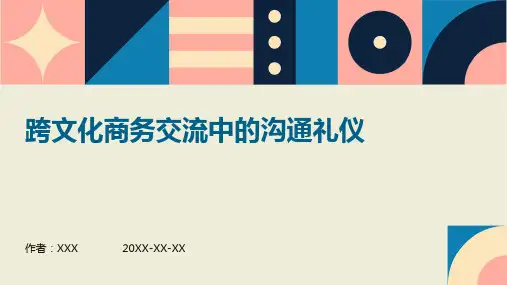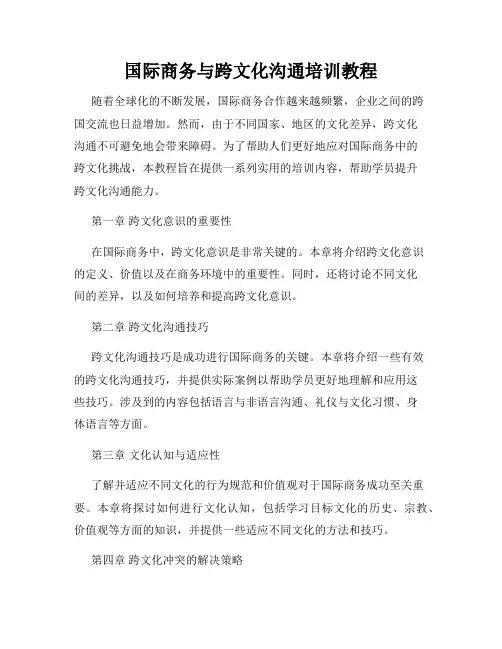第二章 跨文化商务沟通概述
- 格式:ppt
- 大小:42.24 MB
- 文档页数:108







国际商务与跨文化沟通培训教程随着全球化的不断发展,国际商务合作越来越频繁,企业之间的跨国交流也日益增加。
然而,由于不同国家、地区的文化差异,跨文化沟通不可避免地会带来障碍。
为了帮助人们更好地应对国际商务中的跨文化挑战,本教程旨在提供一系列实用的培训内容,帮助学员提升跨文化沟通能力。
第一章跨文化意识的重要性在国际商务中,跨文化意识是非常关键的。
本章将介绍跨文化意识的定义、价值以及在商务环境中的重要性。
同时,还将讨论不同文化间的差异,以及如何培养和提高跨文化意识。
第二章跨文化沟通技巧跨文化沟通技巧是成功进行国际商务的关键。
本章将介绍一些有效的跨文化沟通技巧,并提供实际案例以帮助学员更好地理解和应用这些技巧。
涉及到的内容包括语言与非语言沟通、礼仪与文化习惯、身体语言等方面。
第三章文化认知与适应性了解并适应不同文化的行为规范和价值观对于国际商务成功至关重要。
本章将探讨如何进行文化认知,包括学习目标文化的历史、宗教、价值观等方面的知识,并提供一些适应不同文化的方法和技巧。
第四章跨文化冲突的解决策略跨文化冲突在国际商务中不可避免,有效地解决跨文化冲突对于保持商务关系的稳定十分重要。
本章将介绍常见的跨文化冲突类型,如观念差异、语言障碍、沟通误解等,并提供解决策略和实践经验供学员参考。
第五章跨文化团队管理在国际商务中,跨文化团队的管理能力直接关系到团队的协作和绩效。
本章将探讨如何构建和管理跨文化团队,包括团队成员配备、领导风格、决策模式等方面。
同时,还将介绍解决跨文化团队中的问题和挑战。
第六章跨文化谈判与合作跨文化谈判是国际商务中最常见的情景之一,谈判双方文化的差异往往会给谈判带来挑战。
本章将提供一些跨文化谈判的技巧和策略,并结合实际案例进行详细解析。
同时,还将介绍跨文化合作中的要点和注意事项。
结语本教程旨在帮助学员更好地应对国际商务与跨文化沟通中的挑战,提升自身的跨文化能力。
通过学习本教程,学员将能够更加敏锐地意识到跨文化问题的重要性,掌握跨文化沟通技巧,并有效解决跨文化冲突,从而在国际商务领域中取得更大的成功。

Chapter 1: Communication:An intercultural Perspective 1、N eeds and purposes for communication(1)Maslow’s hierarchy of needs----------be suit of developed country The most basic at the bottom to the most refined at the peak of atriangle---------Physiological needs,such as food,shelter,and sex;Justabove that come the needs of safety like family ; then there are socialneeds for things like love and friendship ; these are followed by egoand esteem needs ,which are above us as individuals wantingself-respect,recognition,and even power;finally ,at the top of thetraingle comes the most sophidticated need----------forself-actulization.this is about self-fulfillment,about finding and beingoneself.(2)For developing countrys-------------10 itemsSurvival ---------rent a flat/shelter ; try to get helpCo-operation---------work with others ;social groupsPersonal needs(within survival)Relationships(love/belonging)PersuasionPowerSocial needsInformationMaking sense of the worldSelf-expression2、d efinition of communication(1)Communication simply refers to the process of sending and receiving messeges among people .-------限定于人(2)Communication is someone perceives behavior or its residue and attributes meaning to it,communication has taken place regardless of whether that behavior is concious or unconcious ,intentional or unintentional . --------------没有限定于人3、the scope and classification of communication(1)there are at least two or more peopleClassification:1) frist classification of communication-----five tapesA :human communicationB : animal communicationC : human – animal communicatiomE : machine-to – machine communicationF : human –machine communication2)the second classification of communication(2)There must be some contact between communicators.(3)There must to be a language shared by communicators.(4)An exchange of information has taken placeThere is often taken as a successful condition of communication .but there are various degrees of success in communication,ranging from complete success,partial success to failure.4、T he process of communicationa)components of communicationThe definition identifies eight key components of communicationwithin the framework of intentional communication:message, ,sender , receiver ,channel , noise , feedback,encoding and decoding.i.messege--------verbal and nonverbal--------carries ideas from oneperson to another.2)sender refers to the person who sends the message .While the receiveris the one who receiver the message. :in order to reduce the uncertaintyor misunderstandings,the sender should think from the receiver’s piontof view when composing the message ,Besides ,the role of sender andreceiver is always changing.3)Channel/Medium refers to the way for sending or receiving message.4)Niose refers to the disturbances along the communicationprocesses ,which may resultunintended message perceived by therecevier .such as environment5)Feedback refers to the reaction from the message receiver to themessage sender.6)Encoding refers to the reaction from the message into asignal;Decoding refers to the process of the receiver interpreting thesignal from the senger.Encoding:the process of collecting message,considered of socialhabits,culture,communications rule.Decoding :the process of collecting feedback.b) Models of communication1. The Linear Model (线性模型)What it basically says is 5Ws:Who A senderSay what Directs a MessageIn which channel Through some MediumTo whom To a receiverAnd with what effect With some effectWhat sender through what message through what channel to whatreceiver with what effectThe theory’s advantages and disadvantagesAdvantages:this is a vary popular model which has been usedby a lot of communication scholars(this is the earlest andstill most useful method);Disadvantage:①human communication involves many morethings. e.g:power relations,rolerelations.age and sex difference,feelings②there are no feesback in this model(itdon’t pay attention to the feedback.).2.The Circular Model(环形模型)The communication is two-way process and thar everyone is both a decoder and an encoder.This model focus on feedback.3)The Contextualized ModelContext refers to the idea that every act of communication must been happen in some sort of surroundings,and what it meant by this is actually quite complicated。



跨文化沟通的要点与技巧范文及概述说明1. 引言1.1 概述跨文化沟通是指不同文化背景下人们进行的交流和理解。
在现代全球化社会中,跨文化沟通成为了一个重要的技能,它有助于促进国际合作、增进人与人之间的相互了解和尊重,并且在各种环境中都能提高个人和组织的绩效。
1.2 文章结构本文将分为五个部分来探讨跨文化沟通的要点与技巧。
首先,在引言部分我将对这篇文章的结构和目的进行介绍。
然后,我们将深入探讨跨文化沟通所需的关键要点,包括理解不同文化背景、尊重和适应他人文化习惯以及学习语言和非语言沟通技巧。
接下来,我们将介绍一些实用的跨文化沟通技巧,如建立信任与合作关系、有效倾听与理解对方观点以及清晰表达自己意思和需求。
此外,本文还将通过实例分析与案例研究来展示跨文化沟通在实际生活中的应用情况,并提供了一些在跨国企业和跨国婚姻中的跨文化沟通问题与解决方案。
最后,我们将在结论与总结部分对全文进行概括和总结,并强调跨文化沟通的重要性和应对策略。
1.3 目的本文的目的是帮助读者了解并掌握跨文化沟通的基本要点和技巧。
通过学习本文所提供的知识和实用建议,读者将能够增加对不同文化背景下人们思维方式、价值观以及行为习惯的理解,进而有效地进行跨文化交流和合作。
无论是在国际商务合作、旅行、社交交往还是其他种种场景中,具备良好的跨文化沟通能力都将带来巨大的优势。
因此,通过深入学习和理解本文所讲述的内容,读者可以在日常生活和工作中更好地应对各种跨文化挑战,并成为成功应对多元文化环境的人才。
2. 跨文化沟通要点2.1 理解不同文化背景在跨文化沟通中,理解不同的文化背景是至关重要的。
每个国家和地区都有其独特的价值观、信仰体系、社交礼仪以及思维方式。
了解对方所处的文化背景能够帮助我们更好地理解他们的行为和决策方式。
这包括了深入学习对方的历史、宗教、传统和社会结构等方面,以便更好地适应他们的文化环境。
2.2 尊重和适应他人文化习惯在跨文化沟通中,尊重和适应他人的文化习惯是必不可少的。